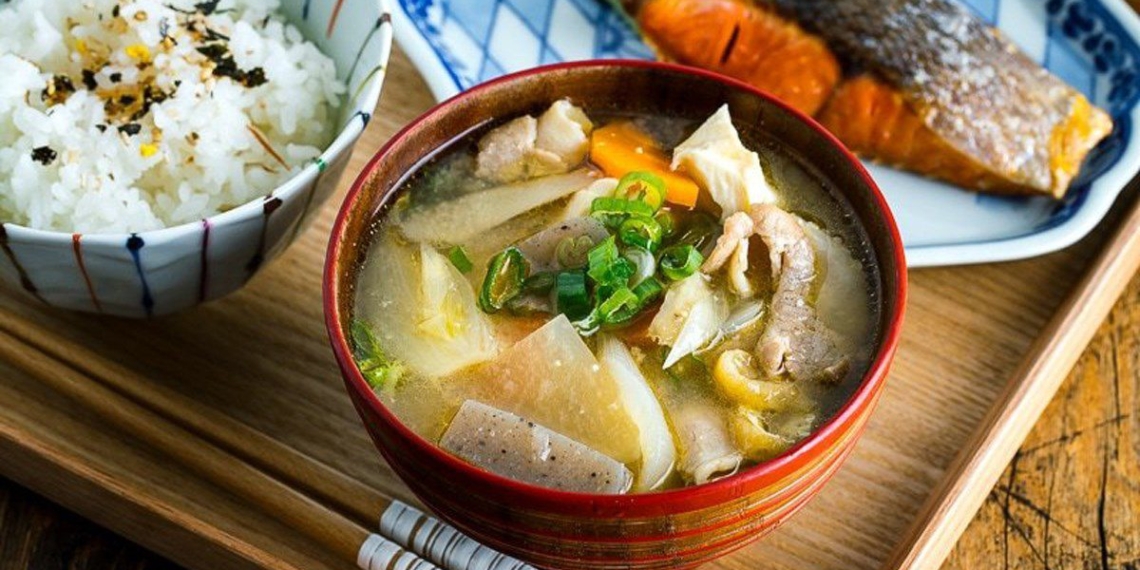-
Preparation
20 minutes
-
Cooking
20 minutes
-
Difficulty
Easy
Tonjiru soup is a traditional soup dish from Japan that is often eaten in winter with seasonal ingredients that not only retain their fresh flavor but are also very nutritious. Today, TasteVN will introduce you to the traditional Tonjiru soup recipe with authentic Japanese flavor, let’s cook it right away!
Ingredients for Tonjiru Soup For 8 bowls of soup
Sliced pork belly 272 gr Burdock root 100 gr (gobo) Taro 227 gr (3 pieces) Onion 1 bulb (170 gr) Radish 247 gr (1 piece about 5 cm) Carrot 123 gr (1 piece about 10 cm) Konnyaku tofu 1/2 piece (128gr) Fried tofu 1 piece (aburaage) White tofu 200 gr Leek 2 stalks Ginger 1 piece (small) Sesame oil 1 tablespoon Miso 6 tablespoons Salt 1/4 teaspoon Dashi broth 1440 ml
How to choose fresh and delicious ingredients
How to choose fresh pork
- For this soup dish, you should buy pre-sliced pork belly at the supermarket; when you get home, you can cook it right away without needing to wash it again.
- For those who do not like too much fat, you can combine it with pork tenderloin and reduce the amount of belly.
- Alternatively, you can also buy fresh pork and slice it yourself. When buying, choose pieces of meat with a thick layer of fat about 1.5 – 2 finger lengths; you can easily observe the thick layer of fat and skin as the simplest feature to identify pork that has not been raised for weight gain.
- You should choose pieces of pork with a distinct texture of meat and fat, but they must stick tightly together; when touched, they feel hard to separate.
- Pieces of meat with fat and lean meat separating, and when touched, a yellow liquid flows out indicate that the pig has been raised with lean-making substances, so do not buy them.
How to choose fresh taro
- For taro, you need to choose those that are round and have a shape like chicken eggs. The outer skin is rough, with many roots and soil still attached to the skin. The size of the taro should be moderate, not too large or too small.
- A tip for you is when you hold a taro root in your hand, if it feels light, then it usually has less water, with a high starch content; when boiled, the taro will have a rich flavor and aroma.
- When selecting taro, the eyes of the taro are also very important. You should closely examine those with many indentations; the more indentations there are, the more delicious and rich the taro will be. If you see taro with few indentations and smooth skin, it is likely that it is not good taro.
How to choose fresh and delicious radishes
- You should choose radishes that are intact, with smooth skin free of scratches, not bruised or having any unusual black spots. Choose radishes that have a straight shape, tapering gradually towards the tail, feel firm when picked up, and have a slight hardness when squeezed, with a certain crispness to the skin.
- Radishes that still have their leaf stalks intact, firmly attached to the bulb, with fresh green leaves, and especially those that still retain root hairs around the bulb are fresh radishes, ensuring quality.
- Avoid choosing radishes that are too large, with swollen and soft bodies, missing leaf stalks, wilted leaves losing freshness, or those with thick, large shoulders, as they often have a lot of fiber and are bland, not tasty.
How to choose fresh and delicious carrots
- Choose carrots of medium size, straight shape, smooth exterior, bright color, small core, and feel firm when held. That’s a good carrot, with a lot of sweetness.
- Avoid choosing large carrots, with big cores, misshapen, cracked skin, and signs of bruising. These may be old carrots, bland in taste and lacking nutrients.
How to choose fresh and delicious onions
- Choose onions that are round in shape with long roots; these are the good ones.
- Good onions will have a firm, smooth skin, a nice yellow color, with no dark spots, and fit closely to the bulb.
- Avoid buying onions that have unusual shapes, have completely lost their roots or have dried-out roots; these onions will not taste good.
How to choose fresh and delicious tofu
For white tofu
- For this dish, you should choose soft tofu or silken tofu, which is dense and not spongy but has a chewy texture without too much water to avoid crumbling when cooking soup.
- When buying tofu at tofu shops, you should choose good pieces that do not contain gypsum, which usually have an ivory color similar to soybeans. You should avoid pieces that are yellowish, as they may have been stored for a long time or contain a lot of gypsum.
- You should choose pieces that feel light in hand, have elasticity, and are smooth without being dry or hard, which easily crumble; these are good tofu pieces.
- In terms of smell and taste, fresh and pure tofu will have a fragrant aroma and the characteristic rich flavor of soybeans. Meanwhile, tofu containing impurities will have a faint smell of lime, and when eaten, it will taste bland, dry, and spongy.
- You can also buy soft tofu sold in supermarkets or large grocery stores like TasteVN, which makes it easier to choose, just make sure to check the packaging and expiration date carefully.
For fried tofu: For the Tonjiru soup, use aburaage, which is tofu cut into thin slices and then deep-fried. You can easily order it on e-commerce platforms. Additionally, you can fry tofu at home without spending too much time! When buying tofu for frying, you should keep in mind a few things as follows:
- You should choose white tofu, which should be soft, smooth, and have a moderate elasticity when held in your hand. It should not be too crumbly or too mushy, as this will prevent the tofu from being crispy and delicious when fried.
- You should not choose types of soft tofu that are packaged in supermarkets because they are very watery and contain a lot of moisture, making them easily breakable. When fried, they do not become crispy, tend to stick to the pan, and can even shrink in size.
- If you want fresh and hygienic tofu, you can easily make it at home with simple recipes from TasteVN!
- You should choose white tofu, which should be soft, smooth, and have a moderate elasticity when held in your hand. It should not be too crumbly or too mushy, as this will prevent the tofu from being crispy and delicious when fried.
- You should not choose types of soft tofu that are packaged in supermarkets because they are very watery and contain a lot of moisture, making them easily breakable. When fried, they do not become crispy, tend to stick to the pan, and can even shrink in size.
- If you want fresh and hygienic tofu, you can easily make it at home with simple recipes from TasteVN!
What is burdock root (Gobo)?
- Burdock is a type of herb originating from Japan, brought to Vietnam for cultivation with many uses such as the ability to treat colds, loss of appetite, digestion, and more. Burdock typically grows wild, reaching a height of about 1 – 1.5 meters, with light purple flowers, large heart-shaped leaves, and a hairy underside. The burdock root grows straight and deep into the ground, forming a tuber, commonly referred to as gobo as a culinary ingredient.
- Fresh roots are the most commonly used part of the burdock plant. Burdock roots are very crunchy and have a mildly sweet taste, with a slight bitterness. However, you can easily eliminate the unpleasant smell by soaking the chopped roots in salt water for 5 – 10 minutes. Additionally, burdock roots can be processed into dried roots, which can be consumed daily as a tea that is very good for health.
- You can order burdock roots on e-commerce websites; when buying, you should choose whole uncut roots to ensure the soup Tonjiru has the right flavor.
What is Konnyaku tofu? Where to buy it?
- Konnyaku tofu or Konjac is a popular food ingredient among the Japanese, made from a type of flour derived from konjac yam, similar to the process of making tofu, resulting in rectangular pieces that are grayish and slightly translucent, with a very light natural salty taste from konjac yam, having little aroma but refreshing.
- The composition of Konnyaku tofu contains up to 97% water, with the remainder being fiber that is very good for health, helping eaters feel full for a longer time. Due to its starch-free composition, it is highly favored as a good food for dieters.
- You can easily purchase Konnyaku tofu at stores specializing in Japanese ingredients or on e-commerce platforms.
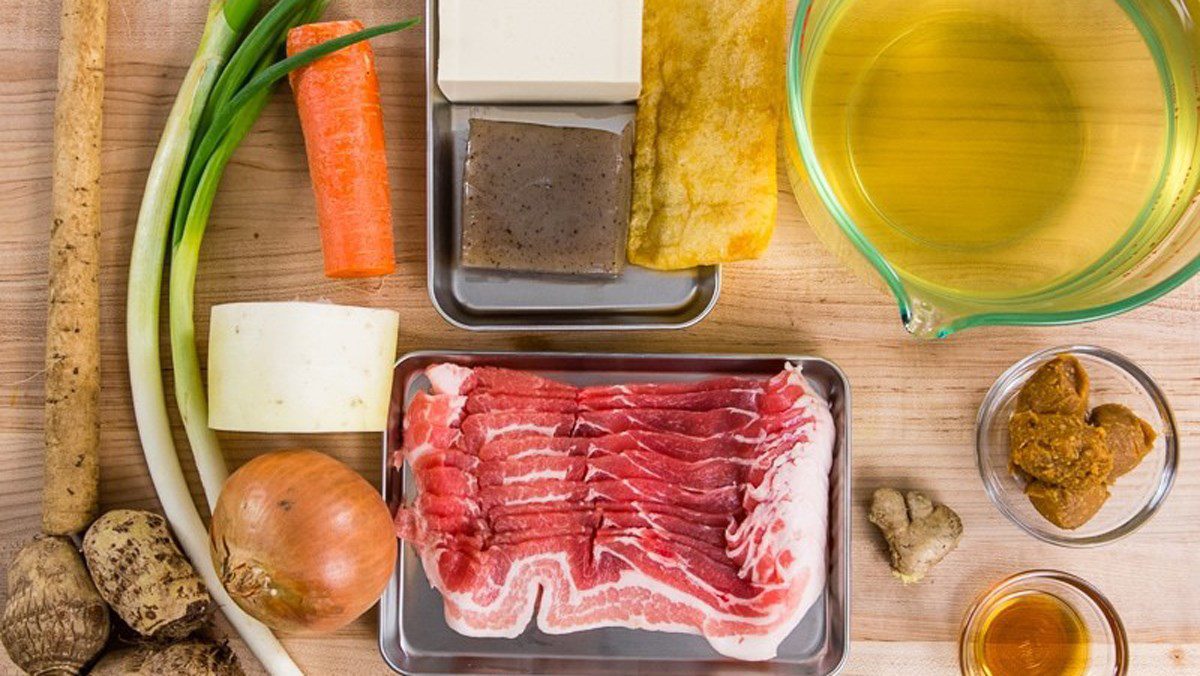
How to prepare Tonjiru Soup
-
Prepare the ingredients
Pork belly slices that you bought should be cut into small pieces about 3 cm.
Tip:
- You should place it in the freezer for about 15 minutes before cutting so that when slicing the meat, it will be beautiful and easier.
- If you buy pork belly that is not sliced, you should keep it in the freezer for about 20 – 25 minutes to easily slice the pork belly, making it more even and visually appealing! However, do not leave it in the freezer too long because if left too long, the moisture in the pork will freeze, making it very hard and impossible to cut by hand.
Next, you use a knife to scrape the skin off the burdock root. Then prepare a basin of water, cutting and rotating the burdock root like sharpening a pencil, and soak the cut burdock root in the water. After finishing cutting, place the burdock root in a basket, rinse it under cold running water to clean off dirt, prepare a bowl of clean water, and soak the washed burdock root to prevent it from turning black.
Taro bought should be peeled, then cut into thin slices about 0.5cm thick and soaked in a bowl of cold water.
Onion should be peeled and washed, then cut into thin long strips about 0.5cm wide vertically.
If the radish is large, divide it into 4 parts and slice them into thin slices about 0.3cm thick; if the radish is smaller, just cut it in half and slice it thinly into half-moon shapes.
Carrots bought should be peeled, washed, then cut in half lengthwise and sliced into thin pieces 0.3cm thick, similar to the radish.
Next, use a knife to cut the tofu into thin rectangular strips about 2cm long, then sprinkle salt on and rub it evenly with your hands, and marinate for 5 minutes.
Boil a small pot of water, when it boils, add the tofu and cook for 2-3 minutes, then remove it to a basket, rinse with water, and set aside.
Green onion should be washed, then cut diagonally on one stalk for soup, and the remaining stalk should be sliced into thin rounds to use as a garnish when serving.
Then use a paper towel to absorb all the oil on the fried tofu, then cut it in half lengthwise, and next slice the fried tofu into thin strips.
Ginger should be peeled, washed, then placed into a grater to grate finely, or you can also mince it if you don’t have a grater.
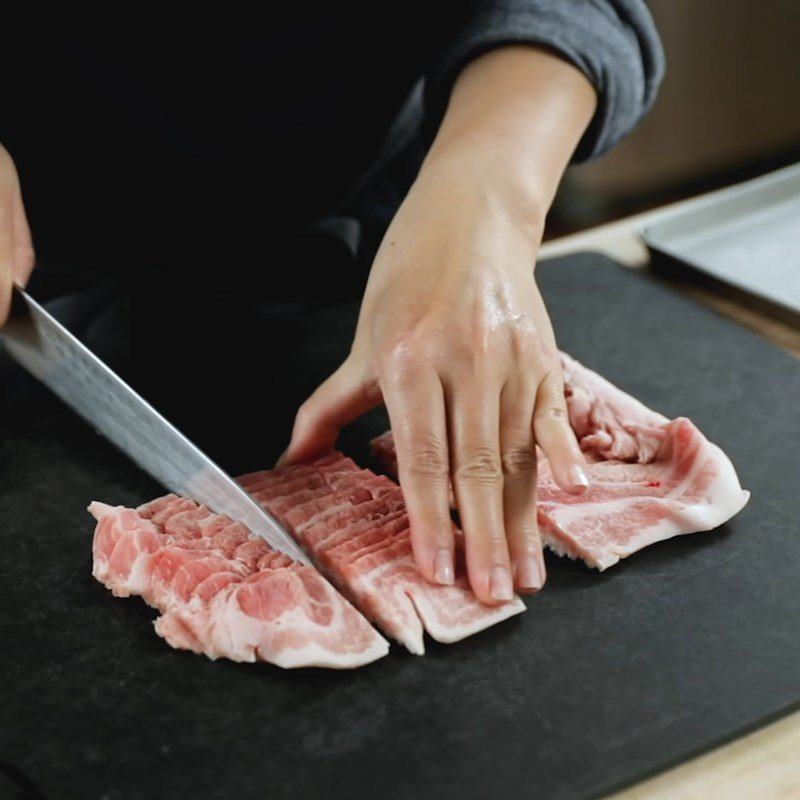
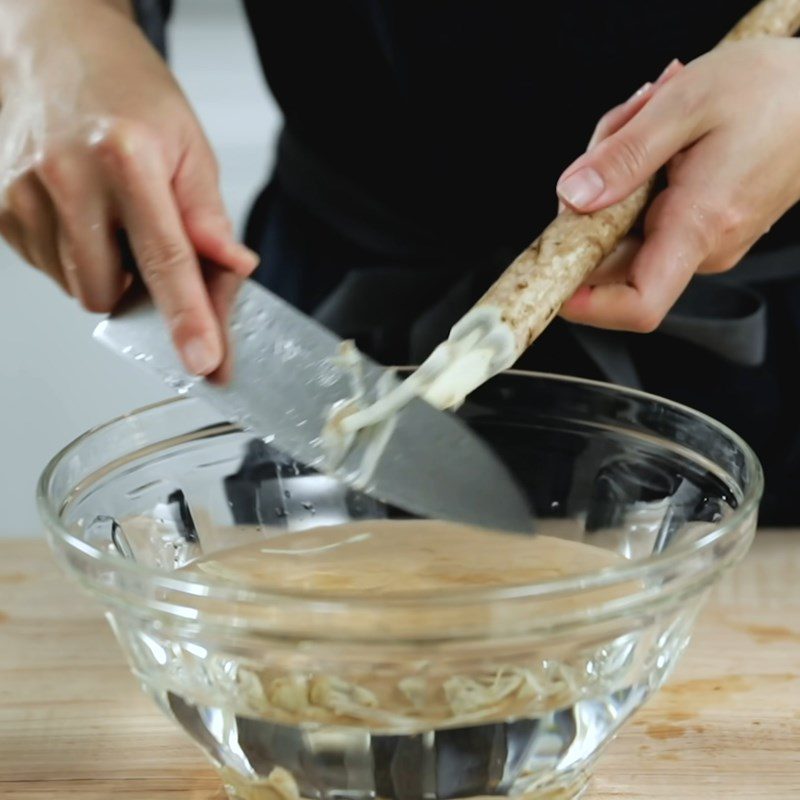
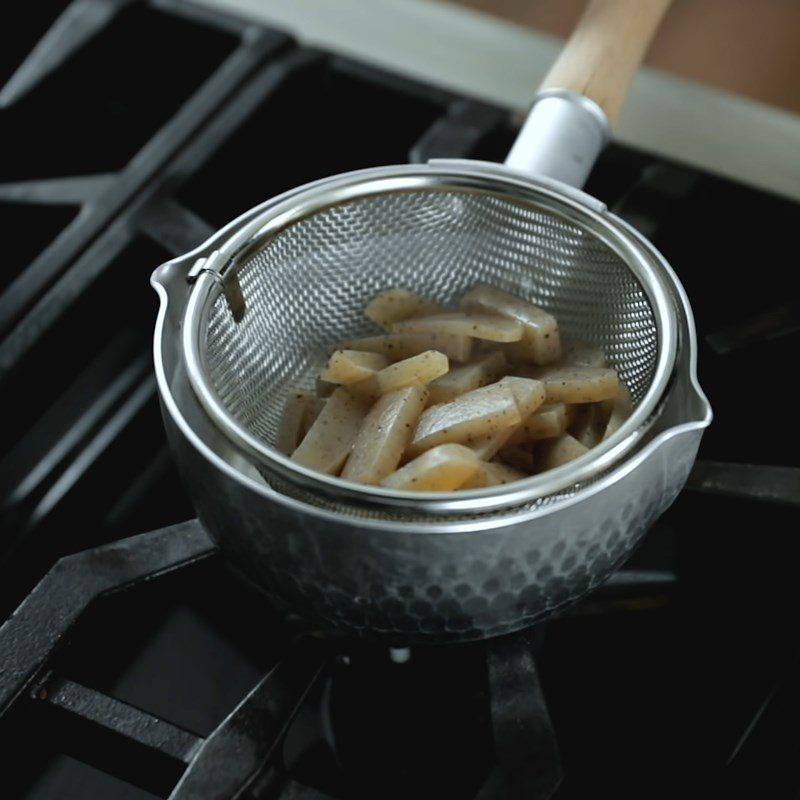
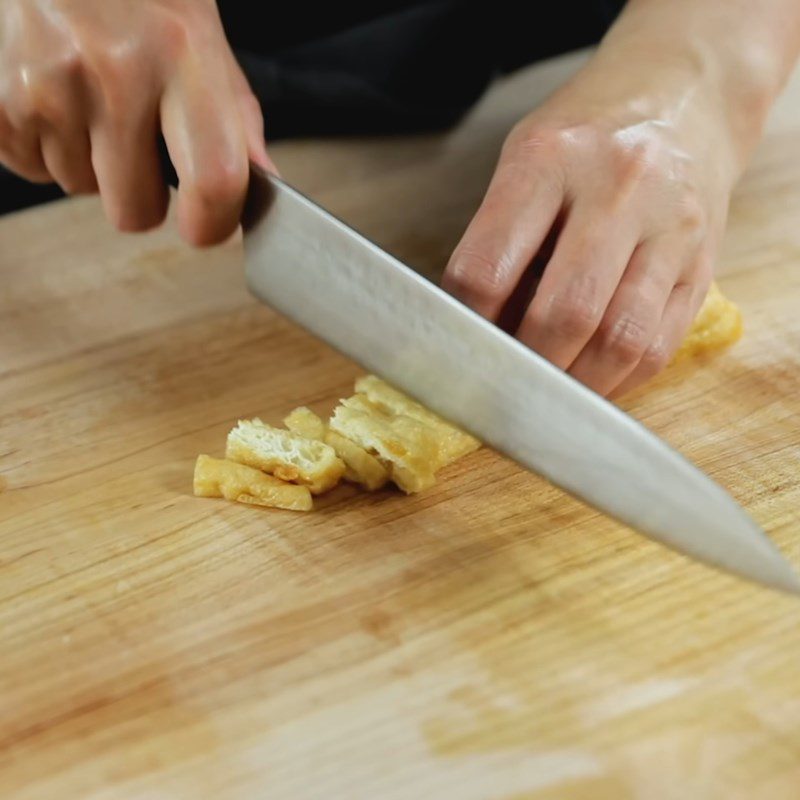
-
Stir-fry the ingredients
Place a pot on the stove, add 1 tablespoon of sesame oil and heat over medium heat until the oil is hot, then add the diced pork and stir-fry until the meat is evenly cooked and no longer pink.
Next, add the onion and stir well, then gradually add the radish and carrot to stir-fry together.
When the ingredients are evenly coated with a layer of oil, continue to add the cow’s tail root and taro to stir-fry.
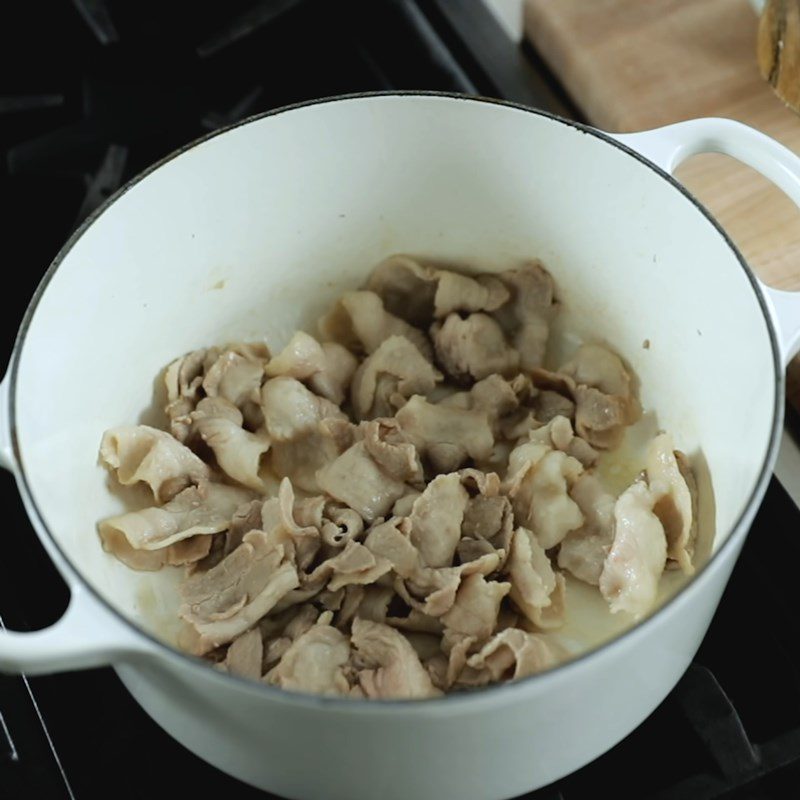
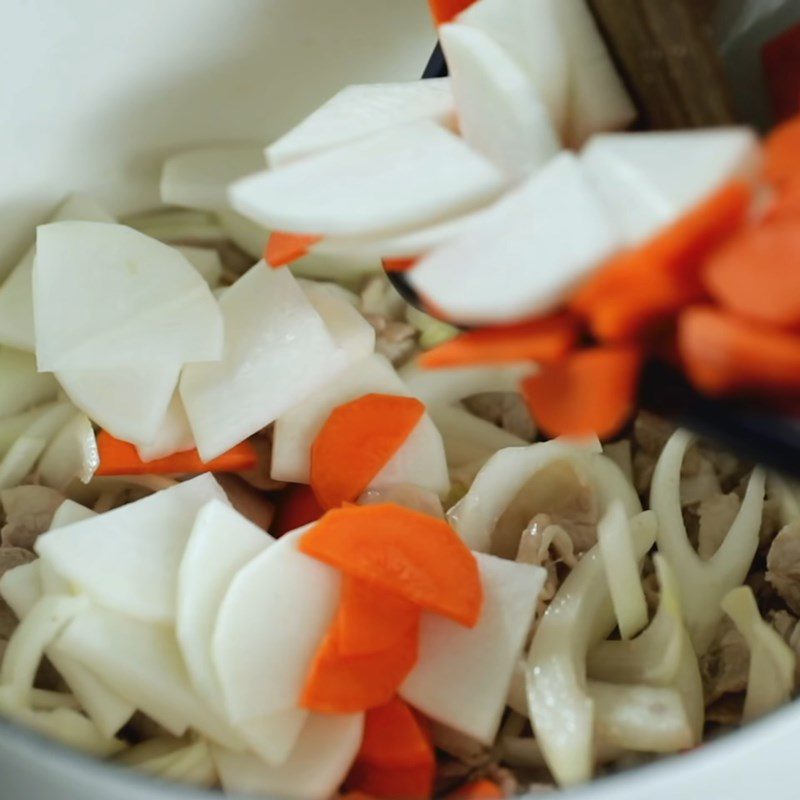
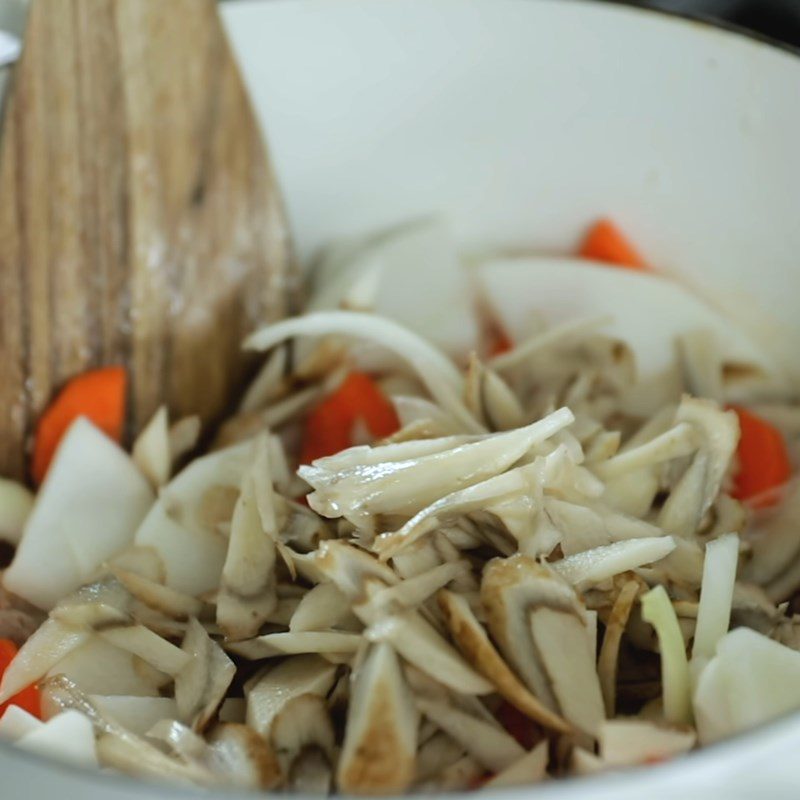
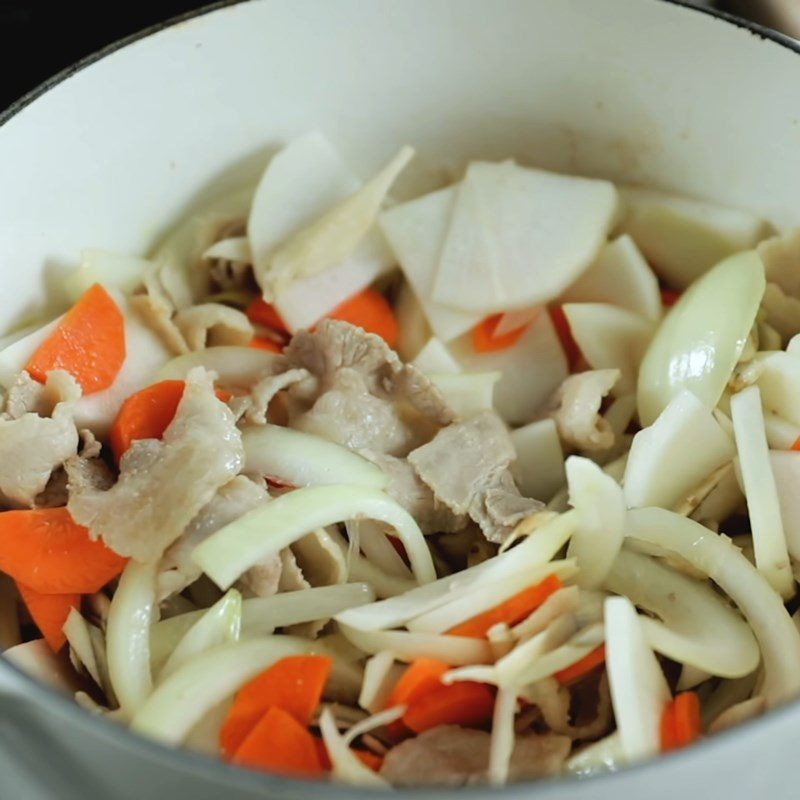
-
Cook Tonjiru Soup
Add tofu, fried tofu, diagonally cut green onion, and dashi broth into the pot with the sautéed ingredients so that the broth covers all the ingredients. If the broth doesn’t cover all the ingredients, you should add more broth or water to ensure that the liquid covers everything.
Next, use a ladle to stir the ingredients evenly, then cover and cook until the water boils, then reduce the heat, open the lid, and start skimming off all the foam and fat from the soup pot.
After skimming off the foam and fat, continue to cover and simmer on low heat for about 10 – 15 minutes until the vegetables are tender. You can use a skewer to test the vegetables; if the skewer goes through all the ingredients, turn off the heat.
Tip: If you are not using it immediately or want to store it for later, you should let the soup cool completely and then place it in the refrigerator to keep for about 5 days.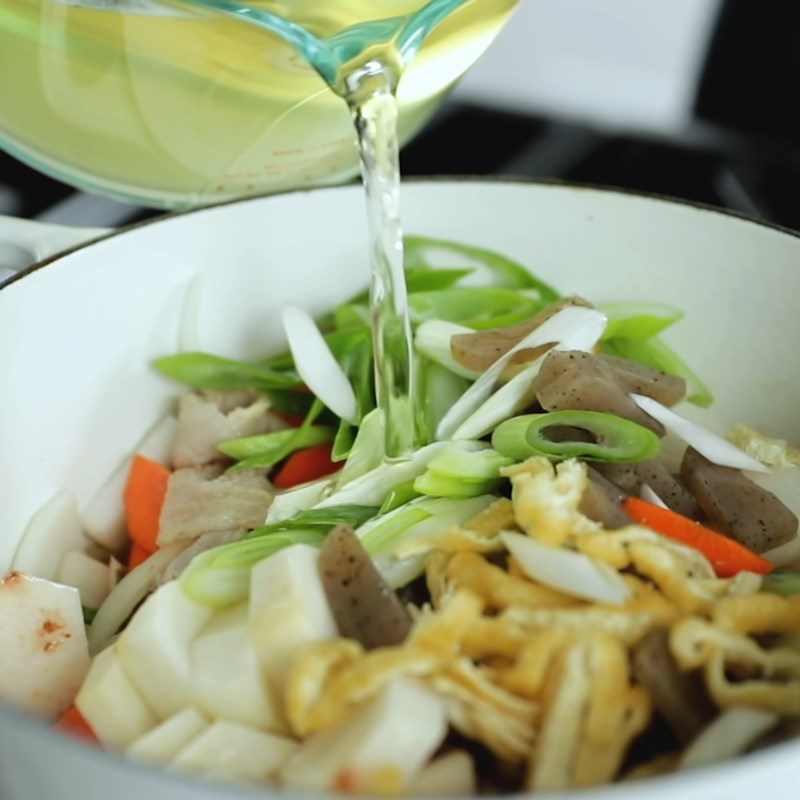
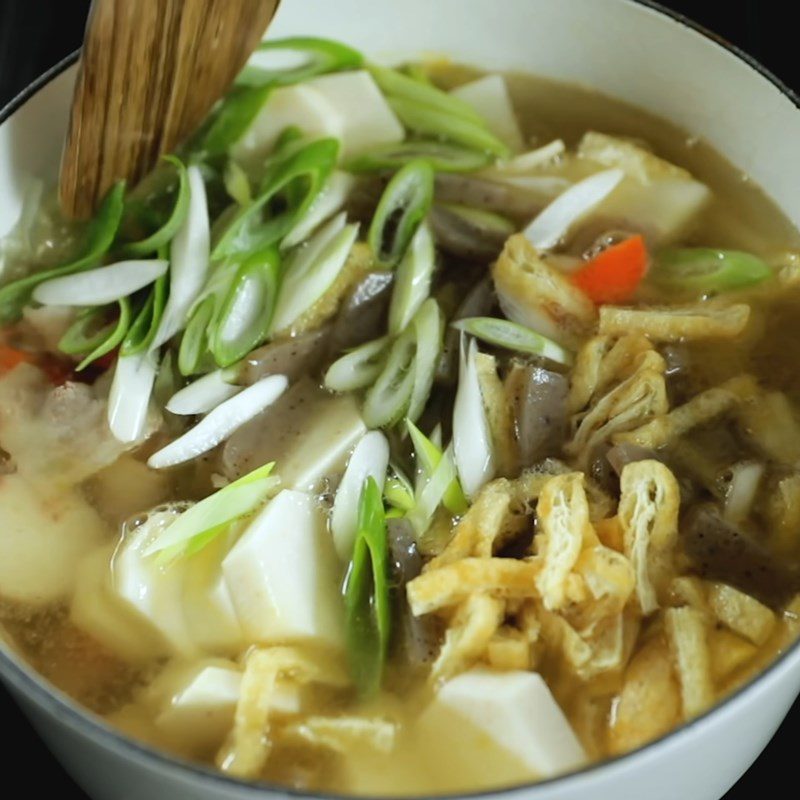
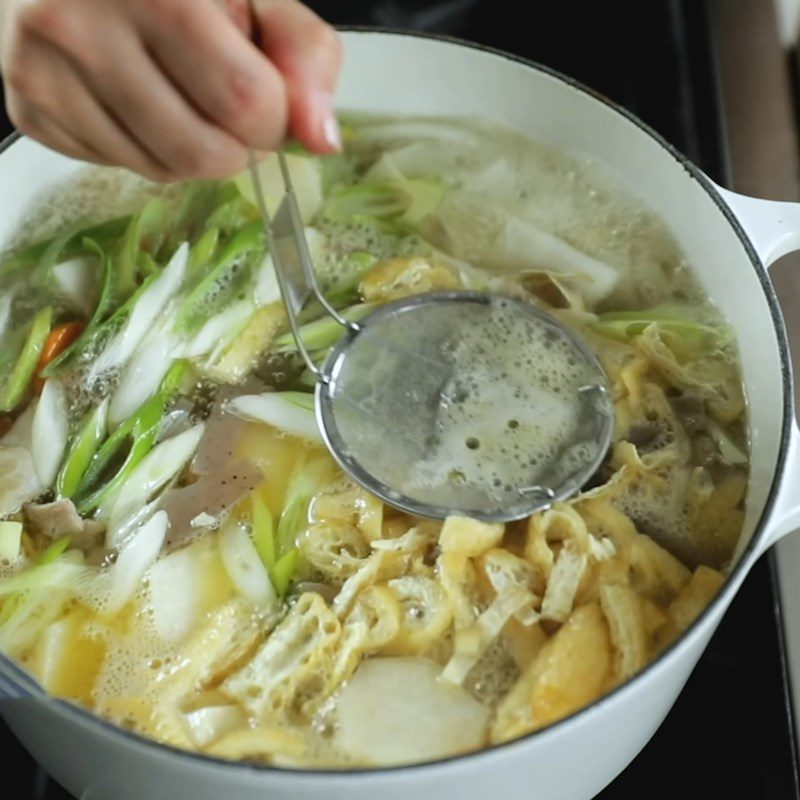

-
Completion
You continue to simmer the soup on low heat, then add a strainer into the pot and mix in 5 tablespoons of miso, stirring well in the strainer to help the miso dissolve more easily. After that, pour all the remaining ingredients from the strainer into the soup pot and stir well.
Tip:
- Each type of miso from different brands will have varying levels of saltiness, so it’s advisable to season with less than the amount in the recipe and add more if the flavor isn’t as strong as desired.
- If you overdo it, you can add dashi broth or water to help reduce the saltiness of the soup.
- If you don’t have a strainer, you can put the miso in a separate bowl, add a little soup water, and stir well to completely dissolve the miso in the bowl before adding it to the soup.
- You should season the soup a bit stronger since when adding tofu, the water in the tofu will dilute the soup.
Once you have seasoned to your liking, add 1 teaspoon of minced ginger and stir well.
Next, tear the tofu into small pieces and add them to the soup pot, stirring gently and keeping it on low heat until serving.
When serving, ladle the Tonjiru soup into a bowl or dish and sprinkle thinly sliced scallions on top, and it’s ready to enjoy!
Tip:- Tearing the tofu into smaller pieces will help it absorb the flavors better and taste nicer. Additionally, you can cut the tofu into small cubes for a nicer presentation, depending on your preference.
- If the soup is cold, you should reheat it on low or medium heat, keeping it warm at a low level, without bringing it to a boil or cooking at too high a temperature, as boiling or cooking at high heat will cause the miso to lose its flavor.
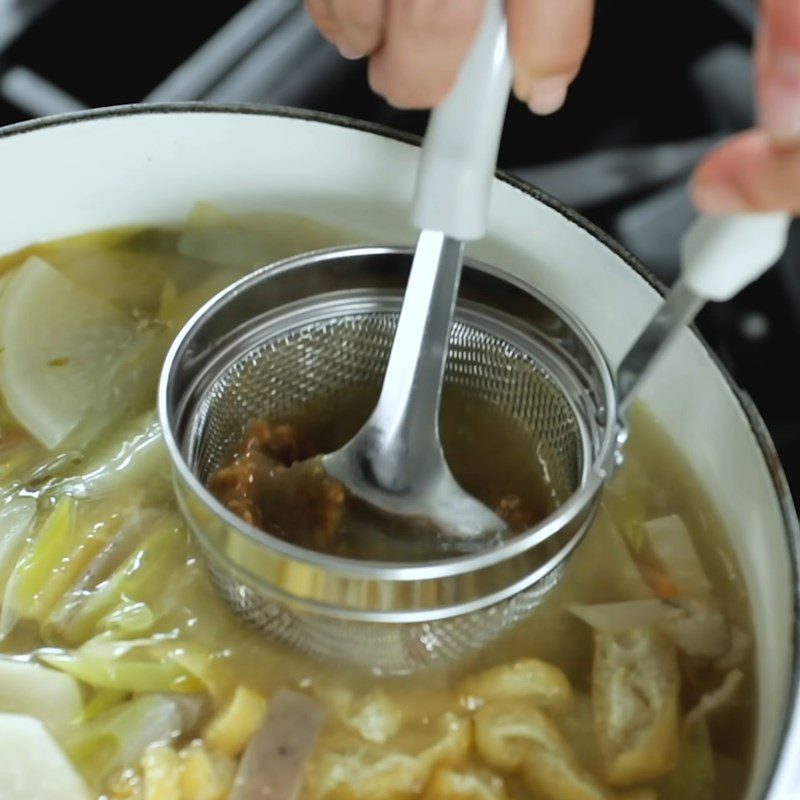
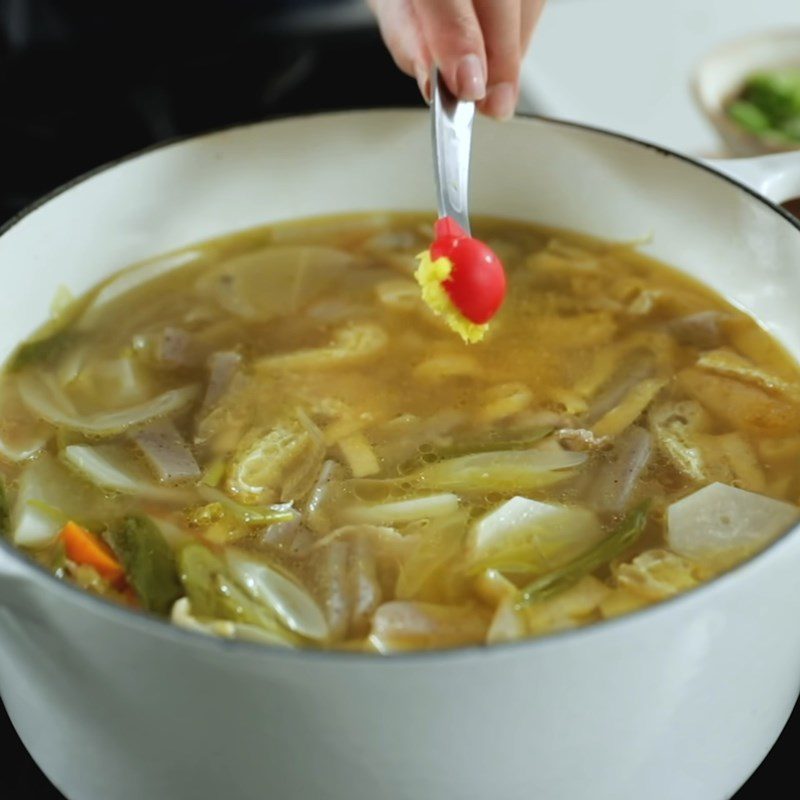
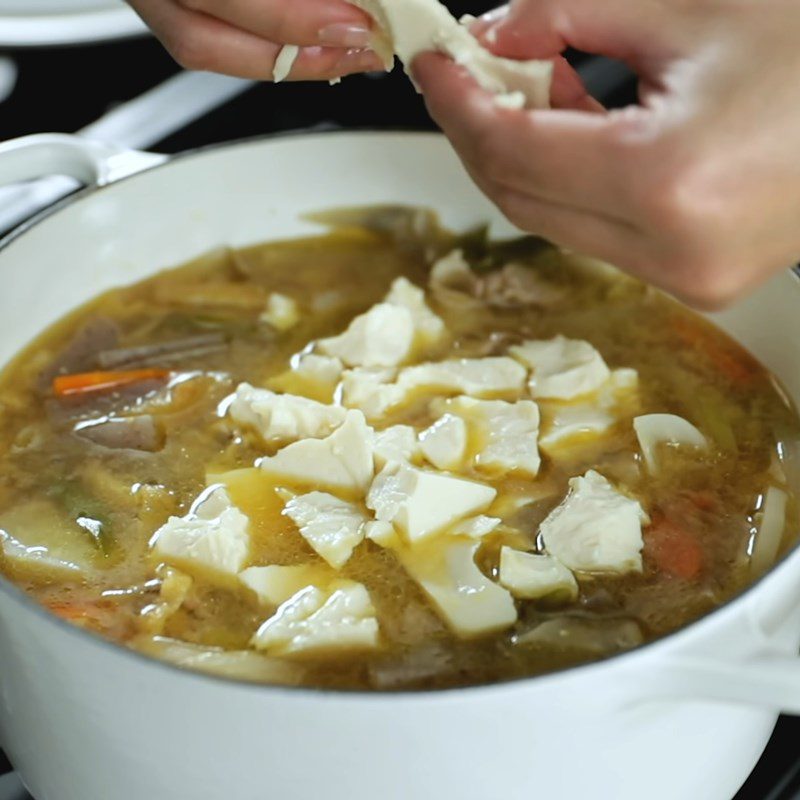
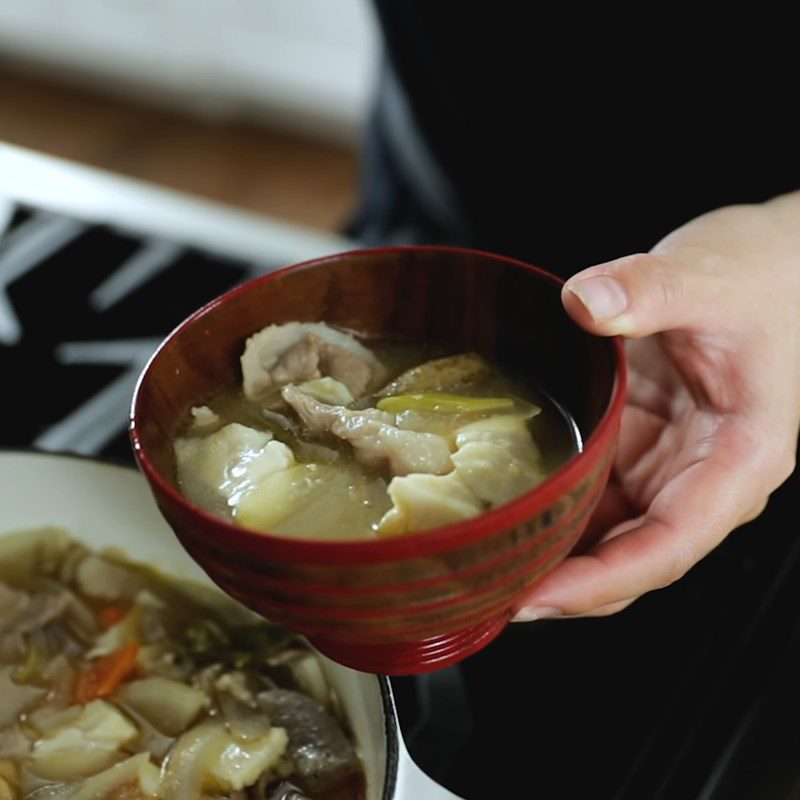
-
Finished Product
Delicious and unique Tonjiru soup, full of nutrition for your whole family with soft-cooked vegetables, meat, and tofu evenly soaked in flavor, perfect for cold weather or rainy days, what could be better than that!
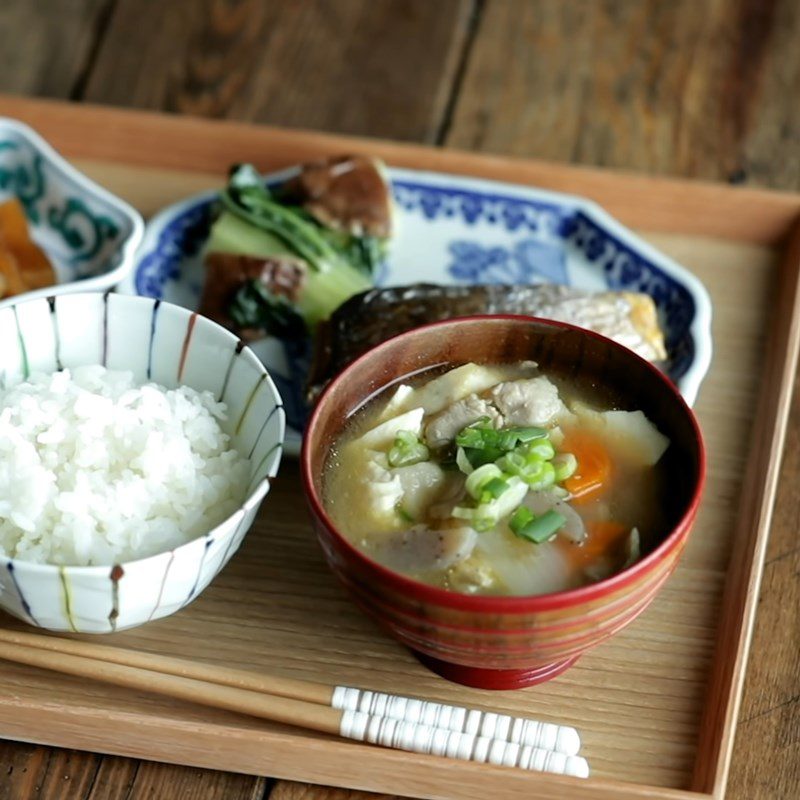
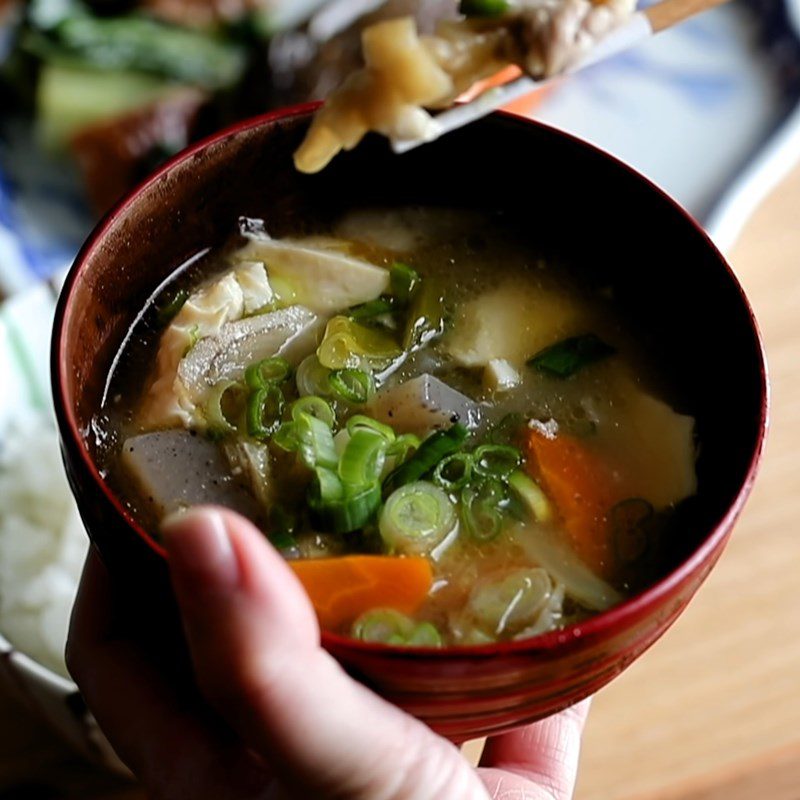
Tips for Vegetarians
- If you are a vegetarian, when making Tonjiru soup, you can replace pork belly with tofu, mushrooms, and vegetables to add more protein and nutrition to the dish.
- You should replace the dashi broth with Kombu Dashi, a Japanese broth suitable for vegetarians.
See more:
With the detailed instructions above, TasteVN wishes you success in making this delicious and nutritious Tonjiru soup, true to Japanese flavor!
